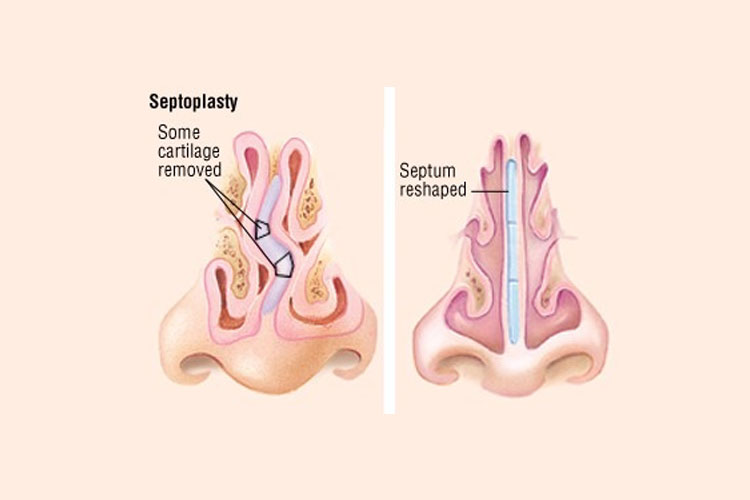What is Septum?
Septum is a wall that normally divides the nose into two equal parts inside. It consists of cartilage in the front and a thin piece of bone in the back and is covered with a skin-like covering called mucosa. On both sides of the nasal cavity, there are tissues called turbinates that provide nasal secretions and are necessary for the continuation of nasal physiology. These organs are 6 in number, three on each side. It may be more in some people.
In a normal nose, the septum is in the midline and the turbinates are of normal size. In the presence of septum deviation, the air passage becomes narrow and enlargements occur in the turbinates.
What is Septum Deviation?
It can simply be called a crooked septum. All or part of the septum is not in the midline and on the side where it is curved, it narrows the nasal air passage. It is usually due to impacts during or after birth. The greater the deviation, the more nasal congestion occurs. Patients usually do not realize this because they can breathe from the non-obstructed side. However, over time, edema and flesh growths (turbinate hypertrophy) occur as a reaction on the normal side and nasal congestion becomes evident.
What Else Does Septum Deviation Cause?
The air necessary for the lungs must pass through the nose. During this transition, the air is subjected to processes such as heating, humidification and cleaning to make it suitable for the lungs. As a result of the deviated septum, air passage through the nose decreases. Untreated air taken through the mouth can cause problems in the upper respiratory tract and lungs. Impairment of air passage due to deviations and hypertrophies also disrupts the movement of normal nasal secretions, causing them to become darker. The patient perceives this as postnasal drip. As these secretions thicken and lose their properties, discomfort increases and it becomes easier for diseases such as sinusitis and polyps to occur.
Another problem is that the olfactory area in the nose is blocked and the scent molecules cannot reach this area, thus reducing the ability to smell.
How to Fix
The only treatment to be applied is to correct this curvature with surgery. In this surgical technique called septoplasty, the crooked septum areas are corrected without damaging the mucosa while preserving the cartilage support. In the techniques applied by some surgeons, drooping and deformities are observed on the back of the nose as a result of the complete removal of the septum cartilages.
In this method, all procedures are performed inside the nose and no incision marks are visible on the outside. Anesthesia can be local or general. The risk of general anesthesia administered in well-equipped operating rooms is quite low with today’s facilities. Nasal tampons placed in the nose after surgery are generally kept for 1-2 days. The tampons used today are soft, do not damage the nose and absorb accumulated blood. Its application and removal does not cause pain.
How Long Does Recovery Take?
There is no swelling or bruising on the face. The patient is usually sent home on the same day. He can do all kinds of activities the next day and return to work within a few days. However, it takes up to 2 weeks for the nasal tissues to fully heal.
What is Turbinate Hypertrophy?
The turbinates (lower, middle and upper turbinates) located on both sides of the nose have important roles in nasal physiology. However, in some cases, they may grow reactively (hypertrophy). Thus, they cause nasal congestion. In fact, it is not desired for the nose to be completely open like a pipe. Inhaled air must hit these turbinates and undergo necessary processes (such as heating, humidification, cleaning). For this reason, although completely removing these turbinates and opening the nasal air passage may initially seem beneficial and comforting to the patient, over time, due to the deterioration of nasal functions, the patient’s complaints increase and treatment becomes impossible. Attempting to shrink these turbinates by using medication and especially nasal drops, which are well-known in the market, will cause further complaints to increase in the future. In this case, called rhinitis medicamentosa, such medications must first be discontinued at the beginning of treatment.
What is the treatment?
First of all, the cause of turbinate hypertrophy must be understood. In the presence of an allergy, appropriate treatment should be initiated. In cases where there is no response to drug treatment, some surgical procedures are performed. Total turbinate resection (cutting out), which is used by many physicians, is not a preferred method. However, partial removals that do not cause loss of function can be made. The last method we use in the treatment of turbinate hypertrophy is radiofrequency reduction surgery. In this method, a device that emits radio waves is entered into the turbinates and sufficient reduction is achieved without damaging the tissue. This procedure is easily performed under local anesthesia, and since postoperative bleeding is rare, a tampon is not placed.

